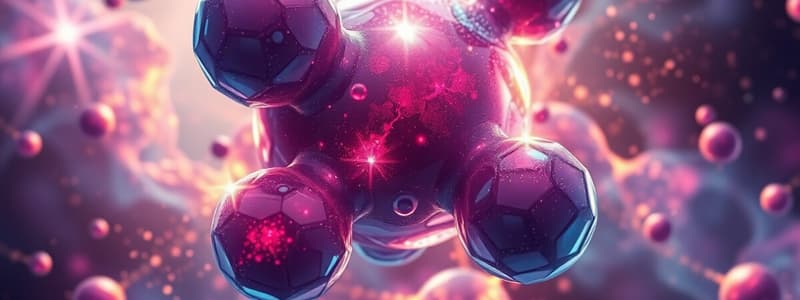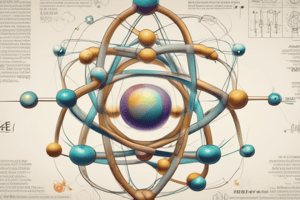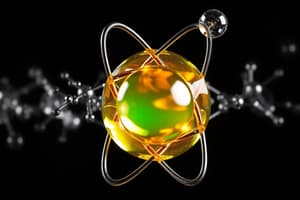Podcast
Questions and Answers
What is a compound?
What is a compound?
- A type of glue
- The powder (crystal) form of a substance
- A building
- Any substance that is composed of two or more different elements chemically bonded together (correct)
What is the difference between a molecule and a compound?
What is the difference between a molecule and a compound?
- A compound is always a molecule, but a molecule does not have to be a compound.
- A compound is a substance that is composed of two or more different elements, while a molecule is a substance composed of two or more atoms, which can be of the same or different elements. (correct)
- Molecules and compounds are both terms that can be used to describe any substance that is composed of two or more atoms.
- A molecule is always a compound, but a compound does not have to be a molecule.
Which of the following subatomic particles has a negative charge?
Which of the following subatomic particles has a negative charge?
- Electron (correct)
- Neutron
- Proton
- None of the above
What is the difference between an element and an isotope?
What is the difference between an element and an isotope?
What is the strongest type of chemical bond?
What is the strongest type of chemical bond?
What is the difference between a polar covalent bond and a non-polar covalent bond?
What is the difference between a polar covalent bond and a non-polar covalent bond?
Which of the following elements accounts for the largest percentage of the human body?
Which of the following elements accounts for the largest percentage of the human body?
Which of the following is not a molecule?
Which of the following is not a molecule?
What happens when an acid and a base react?
What happens when an acid and a base react?
How many fatty acid tails does a phospholipid contain?
How many fatty acid tails does a phospholipid contain?
Which compound is known to remove H+ ions from a solution?
Which compound is known to remove H+ ions from a solution?
Which of the following elements are primarily found in proteins?
Which of the following elements are primarily found in proteins?
What role do nucleotides play in biological systems?
What role do nucleotides play in biological systems?
What characterizes a high pH value in a solution?
What characterizes a high pH value in a solution?
Which statement about hydrogen bonding is false?
Which statement about hydrogen bonding is false?
Which carbohydrate is produced by the human body for energy storage?
Which carbohydrate is produced by the human body for energy storage?
What type of reaction uses water to break covalent bonds?
What type of reaction uses water to break covalent bonds?
Which of the following statements about buffers is true?
Which of the following statements about buffers is true?
Flashcards
Matter
Matter
Any substance that has mass and occupies space.
Subatomic Particles
Subatomic Particles
Particles composing an atom, including protons, neutrons, and electrons.
Element
Element
A type of matter made entirely from one kind of atom.
Atomic Mass
Atomic Mass
Signup and view all the flashcards
Isotope
Isotope
Signup and view all the flashcards
Compound
Compound
Signup and view all the flashcards
Valence Electrons
Valence Electrons
Signup and view all the flashcards
Covalent Bond
Covalent Bond
Signup and view all the flashcards
Ions and electricity
Ions and electricity
Signup and view all the flashcards
Sodium chloride (NaCl)
Sodium chloride (NaCl)
Signup and view all the flashcards
Hydrogen bonds in water
Hydrogen bonds in water
Signup and view all the flashcards
Polarity of water
Polarity of water
Signup and view all the flashcards
Hydrolysis reaction
Hydrolysis reaction
Signup and view all the flashcards
pH scale range
pH scale range
Signup and view all the flashcards
Neutral pH value
Neutral pH value
Signup and view all the flashcards
Function of buffers
Function of buffers
Signup and view all the flashcards
Proteins and elements
Proteins and elements
Signup and view all the flashcards
Catalysts in reactions
Catalysts in reactions
Signup and view all the flashcards
Study Notes
Matter and Atoms
- Matter is any substance with mass and occupies space.
- All matter is composed of atoms.
- Atoms have subatomic particles: electrons (negative), neutrons (no charge), and protons (positive).
- Atoms have no overall charge.
- An element is a substance composed of entirely one type of atom.
- An element is identified by the number of protons.
- Atomic mass is the sum of protons and neutrons.
- Isotopes of an element have the same number of protons but a different number of neutrons.
- 96% of the human body is composed of carbon, hydrogen, nitrogen, and oxygen.
- Trace elements are important for proper bodily functions.
Compounds and Molecules
- A compound is a substance formed by two or more different elements chemically bonded together.
- Molecules are formed when two or more atoms bond together.
- Examples of molecules include water, table salt, glucose, and oxygen gas.
- Valence electrons are those electrons that interact with other atoms.
- Covalent bonds are the strongest type of bond.
- A single covalent bond involves two electrons.
- Polar covalent bonds have uneven electron sharing.
- Ionic bonds involve the transfer of electrons.
- Ions can conduct electricity.
- Sodium chloride (NaCl) is an ionic compound, not a molecular compound.
- Hydrogen bonds are weaker than covalent or ionic bonds.
- Hydrogen bonds are important in water.
- Water's polarity helps dissolve ionic compounds.
- Polar molecules can dissolve in polar molecules.
Chemical Reactions and Solutions
- Water is crucial for living organisms.
- Hydrophobic substances do not dissolve in water.
- Hydrolysis is the chemical reaction that breaks a covalent bond using water.
- An acid releases H+ ions in water.
- A base removes H+ ions from a solution.
- The pH scale ranges from 0 to 14.
- A neutral pH is 7.
- A high pH indicates a basic solution.
- Acids and bases react to form salts and water.
- Buffers resist changes in pH.
Organic Compounds
- Organic compounds contain carbon and hydrogen atoms covalently bonded.
- Carbohydrates are composed of carbon, hydrogen, and oxygen.
- Monosaccharides and polysaccharides are types of carbohydrates.
- Starch, glycogen, and cellulose are polysaccharides.
- Lipids are composed of carbon, hydrogen, and oxygen.
- Triglycerides are composed of glycerol and fatty acids.
- Phospholipids have a phosphate head and two fatty acid tails.
- Proteins are composed of carbon, hydrogen, oxygen, sulfur, and nitrogen.
- Proteins are made of amino acids.
- Enzymes are proteins that speed up chemical reactions.
- Enzymes have specific substrates.
Nucleic Acids
- Nucleotides are the monomers of nucleic acids.
- DNA (deoxyribonucleic acid) is a nucleic acid that stores genetic information; it is an organic molecule with a helical structure.
- Antioxidants protect cells from damage.
Studying That Suits You
Use AI to generate personalized quizzes and flashcards to suit your learning preferences.



